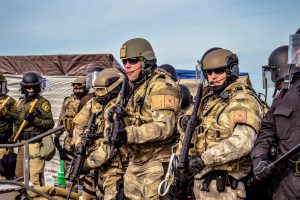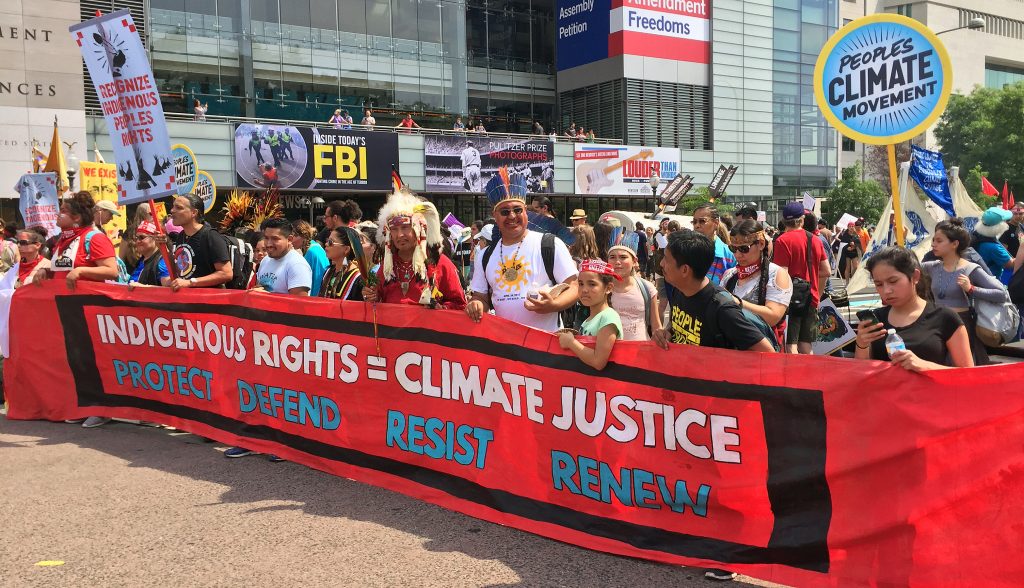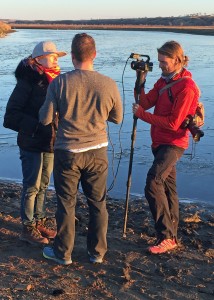As most of my friends know, I am currently working on a master’s in public administration at the John Glenn College of Public Affairs. One of my classes was PUB 6010 Legal Environment of Public Affairs. As part of that class, I was asked to submit a public records request to an agency.
Given that I had recently visited Standing Rock, I decided to submit a request on February 3 to the Ohio State Highway Patrol for all records pertaining to the deployment of 37 state troopers to North Dakota to assist with security regarding protests against the Dakota Access Pipeline near the Standing Rock Sioux Reservation from October 29, 2016, to November 15, 2016.
When a public records request is denied, it’s usually on the grounds that it is too broad. I didn’t think that would apply to my request, which concerned 37 specific officers deployed to a specific location on specific dates. Surely they could produce the records pertaining to that deployment.

Riot Police manhandle peaceful water protectors praying near DAPL construction and desecrated sacred sites on October 22, 2016. Photo by Rob Wilson Photography
On March 17, I received a response from P.R. Casey IV, associate legal counsel and public records manager for the Ohio Department of Public Safety, denying my request on the grounds that it was too broad. He said I had to ask for specific records rather than all records related to the deployment. This was difficult without knowing what specific records they had.
The denial put me in good company: Public records requests from both the Columbus Dispatch and Cincinnati Enquirer had been denied as well. So I called Randy Ludlow, the Dispatch reporter who had filed their request for copies of any use of force reports during the deployment.
I asked if the Dispatch was going to take legal action on their denial. Ludlow said probably yes, so I asked if I could join the case. To that he said no, but he told me about a new procedure to file a complaint about the denial of a public records request through the Court of Claims. After hanging up, I looked up the site and filed a complaint that day, along with the filing fee of $25.
Court of Claims
Within a week, I got a letter from the court saying they were accepting my complaint and referring it for mediation. I then got another letter stating that two attorneys with the attorney general’s office were filing as legal counsel for the state police. Then I got a message from an attorney at the Court of Claims wanting to have a pre-mediation conference.

Ohio state troopers at a protest near Turtle Hill near the Standing Rock reservation on November 2, 2016. By Conor Handley and downloaded by Ohio state police.
All of this freaked me out a little bit, so I did some more research. I found that the large newspapers in the state are represented by attorneys for the Ohio Newspaper Guild. I found names for two attorneys who work on public records law at a high-priced law firm in Cleveland.
On a lark I decided to call one. I was surprised when he picked up on the first ring – I had expected to reach a receptionist or an answering machine. But since he did, I explained the situation and asked his advice. He told me that I couldn’t afford to hire his law firm, but if I would send him an outline of the case, he would take a look and offer some quick thoughts. I was pretty amazed, but I sent him an email the next day, and he responded the day after that.
The attorney’s advice was excellent: Read the Ohio Sunshine Manual, get a book on how to make public records requests, and check out the complaint that the Cincinnati Enquirer had filed in the Court of Claims, which was pretty far along.
I started with the Enquirer case, which was a gold mine. The Enquirer had asked for:
- The names and ranks of the 37 officers sent to North Dakota under the Emergency Management Assistance Compact (EMAC) agreement between the two states
- All communication issued or received by the highway patrol regarding the deployment
- Any documents that outline the actual EMAC agreement between Ohio and North Dakota
- Any highway patrol documents that govern EMAC agreements.
All of these requests were denied for various reasons: 1, because of concerns for the safety of the officers; 2, as overly broad (it was the same request I made and denied for the same reasons); 3, because of security concerns; and 4, because they didn’t have such a document.
The Enquirer case then went to mediation, which failed. At that point the case was assigned to a “special master” named Jeffrey W. Clark to hold a formal legal hearing, then issue a report and recommendation. Clark began by ordering the attorneys for the state to submit a response to the Enquirer’s public records request explaining in detail why they were denying it.
Why the denial

A photo taken by Ohio state police during a protest at Turtle Hill near the Standing Rock reservation. Via Muckrock.
Within two weeks, the state attorneys filed an 84-page document consisting of 19 pages of legal arguments and 65 pages of exhibits, including an affidavit from a commanding officer for the Ohio state police and pages upon pages of what they said were threats to the safety of police officers on social media, including doxxing one North Dakota officer.
The agency’s main reasons for denying the public records request were 1) they didn’t want the identity of the Ohio state police officers known because they were worried about their personal safety, and 2) they cited a pipeline about to be constructed in Ohio and said they don’t want to divulge police strategy because they may want to use that same strategy in case of protests in Ohio.

A woman holds up a feather in front of a line of riot police on November 1, 2016. Photo by Rob Wilson Photography
Regarding their first reason for not producing the records of what Ohio state police did at Standing Rock, I thought they were far too concerned about police safety with very little concern for the safety of water protectors. In all the protests I watched online and heard about through social media, I did not see one single case of a protester carrying a weapon. Instead, I saw that a 19-year-old girl from New York City got her arm blown apart by a concussion grenade, an 18-year-old Sioux girl had her arm broken by police, another Sioux woman lost her eye to concussion grenades, while others were attacked by police dogs badly handled by private security traced to an Ohio kennel through a logo clearly visible on their truck and not licensed in North Dakota.

Remaining in prayer as the militarized police force moves in on the water protectors on Hwy. 1806 on November 1, 2016. Photo by Rob Wilson Photography
More than 100 were arrested at one raid where they were pulled at gunpoint out of a sweat lodge and rounded up at a camp. They were strip searched, had numbers written on their arms, and held in dog kennels before being charged with crimes completely out of proportion to anything they actually did. Most had little money for representation and were railroaded through a system that was stacked against them. In one case, a protester who was hurt badly enough to be hospitalized was shackled to a bed and not allowed to contact his family for weeks. In another, a protester talked an oil worker who had come into camp with a gun into giving up his weapon with no one hurt, yet the protester, not the oil worker, was charged with a felony.
Throughout all of this, the Morton County, N.D., sheriff’s department brazenly lied to the public about events when video easily proved they were lying, yet for months the media reported what the North Dakota police said as the truth while not even talking to protesters. Few journalists actually visited the camps and saw the protests for themselves, and one who did, Amy Goodman, was herself arrested and charged with felony rioting before the judge threw the case out of court.
Had online outlets like Unicorn Riot and TYT Politics, along with citizen livestreamers like Kevin Gilbertt, Johnny Dangers, and Ed Higgins not been there to document events, we would have no idea what really happened, and the Sioux would have been crushed with little fanfare – all because they wanted to protect their water supply from a pipeline that had been rerouted after people in mostly white Bismarck complained about it running next to their town’s water.
All that said – apparently one police officer from North Dakota did have his identity outed on social media (though I never saw it, and I paid a lot of attention to this issue) and felt his safety was threatened. On that basis, I decided to reiterate that identifying information about the Ohio officers could be redacted from any documents released to me. I figured that would be a show of good will and maybe make them more willing to release documents.

A photo taken by Ohio state police deployed to assist with security at the pipeline protests at Standing Rock reservation in North Dakota. Click to enlarge. Via Muckrock
Regarding the second main reason for denying the request – that a pipeline being constructed in Ohio and they don’t want to divulge police strategy because they want to use that same strategy in case of protests here — this was the security exemption they kept claiming for not releasing the records. They don’t want us to know what Ohio state troopers did at Standing Rock because they want to be able to do the same things in case of pipeline protests in Ohio.
The pipeline under construction they were likely referring to is Rover, which is owned by Energy Transfer Partners, the same company that owns Dakota Access, and is slated to go across 18 counties in the state. Construction of the pipeline has begun, and already the state has fined ETP $431,000 for 18 violations of the Clean Water Act, including a spill of millions of gallons of drilling muck that destroyed a Category 3 wetland (the highest quality) in Stark County.
EMAC Agreement
Apparently Clark, the special master in the Enquirer case, was as dissatisfied as I was with the state’s reasons for not releasing public documents regarding the state troopers’ deployment to Standing Rock. On March 8, he ordered the state to send him a copy of the EMAC agreement between Ohio and North Dakota under seal within five days so he could decide if it really was covered by the security exemption that the state attorneys were claiming.
The state then filed a motion for a protective order for the EMAC (the first time I’ve ever heard of protective order being filed for a document). Clark granted this motion, but then ordered the state again to turn over an unredacted copy of the EMAC within five days, then he would have seven days to review it. The state turned over the EMAC on March 30, then on April 4 the state filed a motion requesting the EMAC be returned. On April 13, Clark filed for a seven day extension to review the EMAC. A few days after that, Gov. John Kasich took public responsibility for ordering the deployment of Ohio state troopers to Standing Rock.
Finally on April 24, Clark issued his report and recommendation regarding the Cincinnati Enquirer’s four-part public records request. On the first request for the names and ranks of Ohio state officers sent to North Dakota, Clark found the state had “improperly denied” this request. It was okay to withhold the names while the officers were on deployment, but now several months after their return, the state had not demonstrated the officers were at risk of harm, Clark said.
On the second request for all communications issued or received by the highway patrol regarding the deployment, Clark supported the state’s denial on the grounds it was too broad. He said the state had given the Enquirer a chance to file a narrower request, but the Enquirer had not done so.
On the third request for the EMAC agreement, Clark found it should be released. The state had asserted the document contained deployment plans, vulnerability assessments, and tactical response plans, but Clark found most of it was administrative and billing information. The state had also claimed releasing the EMAC would put other states that had agreements with North Dakota at risk, yet at least six other states had already released their own EMAC agreements.
Clark did say a few portions of the EMAC could be redacted under the security exception, such as some of the militarized police equipment – yet Indiana’s EMAC contained the entire list, including 42 sidearms, 37 AR-15 rifles, 16 riot gear outfits, and 23 shotguns, among other things.
On the fourth request for policies governing EMAC agreements, the state denied the request on the basis that no such documents exist, and Clark supported the denial.
Incredibly, after the special master found the state should release the EMAC agreement, the state still refused to do so. The point of contention is the names of officers who were deployed, which are listed in the document. The state simply said no to the special master’s recommendation. The case then went to an actual trial judge at the Court of Claims, who upheld the special master’s recommendation and ordered the state to turn over the EMAC agreement. The case can now be appealed to the 10th District Court.
My public records case

A photo taken by Ohio state police looking down on activity from atop Turtle Hill. Via Muckrock. Click to enlarge.
Shortly after my public records complaint was accepted at the Court of Claims, I got a call to have a pre-mediation conference with an attorney at the court. She kept asking me specifically which records I wanted from the state police. Without knowing what they have, I just reiterated that I didn’t see why a request for records regarding specific officers sent on a specific mission at a specific location on specific dates was too broad. She said it’s possible the state police would have personal correspondence with their families in the documents. I responded that I didn’t see why state police would be sending their wives grocery lists over the state email system. The court attorney then said it was likely my case would go to mediation.

Warrior woman water protector holds sage and walks in front of riot police near the desecrated sacred sites and DAPL construction on October 22, 2016. Photo by Rob Wilson Photography
A week after that, I got a message from P.R. Casey, the attorney who had originally denied my request. He said he had a proposal for me. When I called back, he talked to me for a half-hour, which surprised me he would spend that long on my case. Casey offered to send me everything he had already sent other reporters who had filed public records requests to see if that would satisfy what I was looking for.
He also reiterated that I needed to ask for specific records. I told him that was difficult without knowing what specific records they had, and he acknowledged that was a catch-22. I agreed to look at the documents he sent, and if that wasn’t enough, maybe they would help me pinpoint specific records to request. Casey then asked if I would drop my case with the Court of Claims. I said that would depend on what I found in the documents, and he admitted that it might be up to the mediator to decide if a further request would be a new case or an addendum to this case.
A few days later, I got a huge stack of documents in the mail. They consisted of the following:
- Information sent to the deploying officers including weather reports in North Dakota, employee assistance information, how to vote absentee, and how to get travel reimbursements.
- A use of force incident report with so much redacted that there’s no way to know what happened except that it was at Mandan County Correctional Center, where many of the people arrested at Standing Rock were held.
- Financial documents showing that Ohio state police requested $574,271 in reimbursement from North Dakota for the cost of the deployment – $512,921 for personnel costs including $271,992 in overtime, plus $58,824 in travel costs and $2,530 in assorted costs including $1,473 for a cost that was redacted. It also showed the officers routinely worked 12 to 14 hour days while deployed at Standing Rock.
- One disk of photos and videos taken by Ohio state troopers during the deployment, and one disk of videos taken by others during the deployment. The first disk showed that police had a sniper positioned on a hill above one of the main protest locations, and that they had someone embedded in with the protesters during the action. The second disk included video of activist Erin Schrode being shot by a rubber bullet. See more here
- One commander’s personnel file with personal information redacted, with a promise to go through the emails of two commanders that reference North Dakota or the Emergency Management Assistance Compact.

Sniper shown sitting on top of Turtle Hill in photo released by Ohio state police. Via Muckrock. Click to enlarge
This was a lot of interesting information, especially the photos and videos, which were released without any difficulty. I’ll have to remember that as a public records request trick next time. Another trick was asking for emails from addresses ending in “nd.gov” or “mortonnd.org” or addressed to specific commanding officers with the Ohio state police. A third trick was asking for financial documents.
A few weeks later, P.R. Casey sent another thing I had asked for, the list of other public records requests the state police had received from the date of the deployment until the present. I had meant to ask only for other requests about the deployment to Standing Rock, but what Casey sent me was an 88-page list of every request the state police have gotten. Most were news media and attorneys asking for accident reports. Only a few were about Standing Rock. It is interesting to see the sheer volume of requests this agency gets every week – it’s a lot.
Mediation

Protests at the bottom of Turtle Hill in a photo taken by Ohio state police. Via Muckrock. Click to enlarge.
After that, the attorney from the Court of Claims contacted me again to ask if the response to my complaint had satisfied me or if I wanted more documents. From looking at the documents Casey sent, I was able to decide which specific things I wanted to ask for: a copy of the EMAC agreement, which for my purposes could be redacted; copies of the daily briefings given to Ohio state troopers; and any use of force reports, the same request as was made by the Dispatch.
Like the Cincinnati Enquirer case, my case did end up going to mediation. During a 30-minute teleconference, state attorneys agreed to send me a copy of the EMAC with the officers’ names redacted, but denied my requests for the daily briefings and use of force reports on the basis of the security exemption to the Public Records Act.

This is the militarized police force sent to confront and remove water protectors on November 1, 2016. Photo by Rob Wilson Photography
The attorneys did clarify that the redacted use of force report they had sent previously was really a compilation of all the RTR, or response to resistance, reports that Ohio state troopers had filed during the entire deployment to North Dakota. They thought these reports would have the details I was looking for about what exactly Ohio state troopers did in Standing Rock, but that was also why they had redacted all of the information.
After that, the mediator asked me to dismiss my complaint so they could close my case. He said if I want to pursue additional legal action to get the briefing emails and response to resistance report, I would have to submit a new public records request, have that denied, go through mediation again, and likely take it to a trial court, where I would need to counter the state’s arguments as to why these documents can be withheld under the security exemption.
That’s really beyond what I as a citizen without an attorney or time to do detailed legal research can do, and I’m sure they know that. The Dispatch was also denied access to the use of force reports, and unlike me, they have attorneys, so I hope they pursue their case as the Enquirer did.
Postscript
Three days after my mediation, The Intercept published leaked copies of 13 briefings given by a private security firm called TigerSwan to officers deployed to Standing Rock. The documents are appalling. They show exactly what all of us thought – that police were conducting nothing less than a counter-insurgency operation such as our troops have done in Iraq – only this one was aimed against peaceful American citizens simply trying to protect their water. The report shows how militarized police treated water protectors as jihadist enemy to find, fix and eliminate. It is a must-read for anyone who wants to understand what happened at Standing Rock.








































